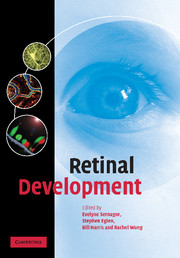Book contents
- Frontmatter
- Contents
- List of contributors
- Foreword
- Preface
- Acknowledgements
- 1 Introduction – from eye field to eyesight
- 2 Formation of the eye field
- 3 Retinal neurogenesis
- 4 Cell migration
- 5 Cell determination
- 6 Neurotransmitters and neurotrophins
- 7 Comparison of development of the primate fovea centralis with peripheral retina
- 8 Optic nerve formation
- 9 Glial cells in the developing retina
- 10 Retinal mosaics
- 11 Programmed cell death
- 12 Dendritic growth
- 13 Synaptogenesis and early neural activity
- 14 Emergence of light responses
- New perspectives
- 15 Regeneration: transdifferentiation and stem cells
- 16 Genomics
- 17 Zebrafish models of retinal development and disease
- Index
- Plate section
- References
16 - Genomics
Published online by Cambridge University Press: 22 August 2009
- Frontmatter
- Contents
- List of contributors
- Foreword
- Preface
- Acknowledgements
- 1 Introduction – from eye field to eyesight
- 2 Formation of the eye field
- 3 Retinal neurogenesis
- 4 Cell migration
- 5 Cell determination
- 6 Neurotransmitters and neurotrophins
- 7 Comparison of development of the primate fovea centralis with peripheral retina
- 8 Optic nerve formation
- 9 Glial cells in the developing retina
- 10 Retinal mosaics
- 11 Programmed cell death
- 12 Dendritic growth
- 13 Synaptogenesis and early neural activity
- 14 Emergence of light responses
- New perspectives
- 15 Regeneration: transdifferentiation and stem cells
- 16 Genomics
- 17 Zebrafish models of retinal development and disease
- Index
- Plate section
- References
Summary
Introduction
Many distinct processes occur during the course of retinal development. These range from regulation of mitosis and cell fate specification to axon outgrowth and targeting, dendritogenesis and terminal differentiation of different cell types. Since all of these events require changes in gene expression, it follows that global analysis of changes in transcription during development should reveal the identity of many of the genes that mediate these processes. This has been the logic underlying genomic studies of the developing retina, which have so far been undertaken by a number of groups.
The retina has many features that make it well suited to genomic studies. In both invertebrates and vertebrates, the major cell subtypes in the retina are easily distinguished by both molecular and morphological criteria. Compared with other parts of the nervous system, the number of distinct retinal cell subtypes is quite limited and, in both rodents and flies, photoreceptors make up the majority of retinal cells. The birth order of each major cell type is known, and in vertebrates these generation times are distinct and only partially overlapping. Cell types are readily identified by spatial position, which renders in situ hybridization-based verification of primary expression data relatively straightforward. Interpretation of expression data in model organisms is also aided by previous work that has already identified large numbers of genes that are selectively expressed in specific cell types of the mature and differentiating retina. Finally, a wealth of mutations that disrupt different aspects of retinal development are available.
- Type
- Chapter
- Information
- Retinal Development , pp. 325 - 341Publisher: Cambridge University PressPrint publication year: 2006



